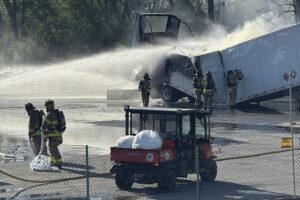WASHINGTON — To enhance the safety of the nation’s roadways, the Federal Motor Carrier Safety Administration must address the increase in fatalities involving large trucks and buses.
So says the report on the Department of Transportation’s Fiscal Year 2020 top management challenges published October 23 by the DOT’s Office of Inspector General.
The report noted that fatalities have consistently risen in recent years — from 4,455 in 2013 to 4,949 in 2018, an 11 percent increase.
“Enhanced enforcement and data analysis are important tools for improving the safety performance of commercial motor carriers and their drivers and vehicles,” the report said.
To begin to reverse the trend, the OIG made three specific recommendations:
- Ensuring commercial drivers are qualified to operate large trucks and buses
- Prioritizing motor carriers for interventions
- Estimating the impact of driver detention on the motor carrier industry
The OIG admitted that because of the volume of drivers and differences in states’ commercial driver’s license (CDL) programs, FMCSA faced challenges in ensuring both drivers and states comply with federal requirements.
In particular, the Commercial Motor Vehicle Safety Act of 1986 requires states to exchange information on commercial drivers through a nationwide information system, and established penalties, including CDL disqualification, for serious traffic violations.
“Yet weaknesses in timely information sharing have led to unqualified drivers remaining on roads,” the OIG said.
The report cited an example where a driver with a Massachusetts CDL was recently arrested in Connecticut for operating under the influence and six weeks later, he was involved in a fatal crash in New Hampshire.
The violation in Connecticut should have resulted in disqualification of the driver’s CDL.
An internal review conducted by the Massachusetts Registry of Motor Vehicles (RMV) revealed that RMV officials did not timely review notifications of numerous out-of-state violations. Furthermore, a flaw in RMV’s electronic registry system inappropriately “kicked out” some notifications from other states. RMV has since issued suspensions of over 2,000 CDLs after reviewing its backlog.
The report also called on FMCSA to take action to ensure that commercial drivers maintain valid medical certificates noting that since August 2014, OIG investigations of the medical certification process have resulted in eight indictments and six convictions related to fraud.
The OIG called prioritizing motor carriers for interventions an ongoing challenge for FMCSA
FMCSA uses a data-driven safety compliance and enforcement program called the Compliance, Safety, and Accountability (CSA) program. FMCSA commissioned the National Academy of Sciences (NAS) to study the CSA program and developed a corrective action plan to address NAS’s recommendations, but the OIG said a recent audit on FMCSA’s corrective action plan found that the agency had addressed some, but not all, of the NAS recommendations.
“For example, NAS recommended that FMCSA develop an Item Response Theory (IRT) model over the next 2 years, and if it performs well in identifying motor carriers for intervention, to use the model to replace SMS,” the OIG said. “To address this recommendation, FMCSA has developed and tested IRT to gauge its suitability for prioritizing motor carrier safety interventions and plans to decide whether it will adopt IRT by September 2020.”
Further, the OIG said FMCSA’s corrective action plan lacked implementation details to address NAS recommendations on improving the transparency of the agency’s data and also lacked details on improving its assessment of motor carrier safety rankings, such as the use of percentile rankings and relative and absolute measures to support decisions regarding which carriers receive safety alerts. FMCSA plans to address these areas once it decides whether to adopt IRT to prioritize carrier safety interventions, the OIG said.
As for detention, the OIG said FMCSA’s efforts to improve commercial vehicle safety also depend on obtaining an accurate understanding of the role of driver detention within the industry. Specifically, to reduce driver fatigue and fatigue-related crashes, FMCSA’s Hours of Service regulations limit the number of hours a driver can work. Drivers who experience excessive delays at shipping and receiving facilities may violate HOS regulations or drive unsafely because of fatigue or the desire to recover lost income, increasing the risk of crashes that result in fatalities, injuries, and financial costs.
The Fixing America’s Surface Transportation Act of 2015 directed FMCSA to issue regulations that cover the collection of data on delays experienced by commercial vehicle operators before the loading and unloading of their vehicles. However, in 2018, the OIG said it reported that accurate industrywide data on driver detention do not exist. These data are not available because most industry stakeholders only measure time spent at shippers’ and receivers’ facilities beyond the limit established in shipping contracts. Available electronic data cannot readily discern detention time from legitimate loading and unloading tasks, and are unavailable for a large segment of the industry, the OIG said.
FMCSA data estimated that driver detention increases the likelihood of truck crashes involving fatalities, significant injuries or vehicle towing.
“We estimated that a 15-minute increase in average dwell time—the total time spent by a truck at a facility — increases the average expected crash rate by 6.2 percent. We also estimated that detention is associated with reductions in annual earnings of $1.1 billion to $1.3 billion for for-hire commercial motor vehicle drivers in the truckload sector,” the report said.
Without accurate and representative data, FMCSA faces challenges in accurately describing how the diverse trucking industry experiences driver detention, the report concluded.
The Trucker News Staff produces engaging content for not only TheTrucker.com, but also The Trucker Newspaper, which has been serving the trucking industry for more than 30 years. With a focus on drivers, the Trucker News Staff aims to provide relevant, objective content pertaining to the trucking segment of the transportation industry. The Trucker News Staff is based in Little Rock, Arkansas.








